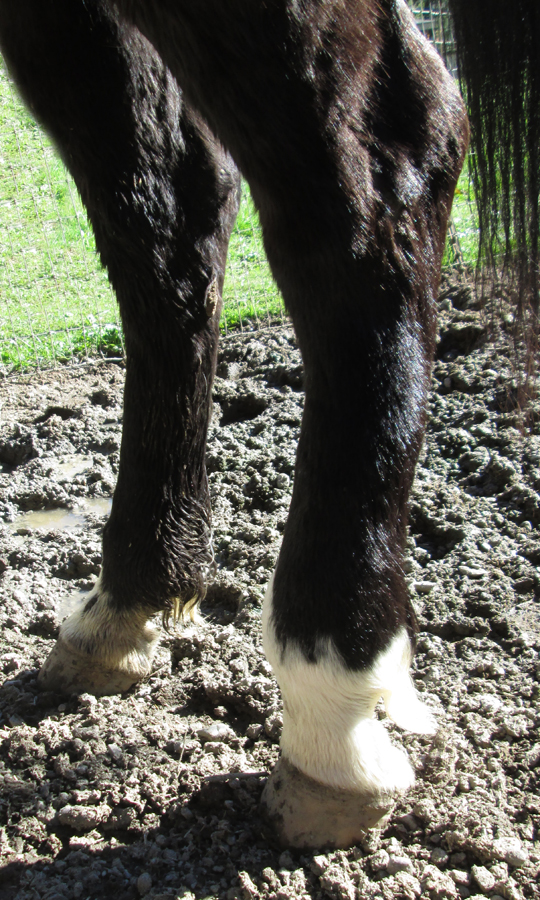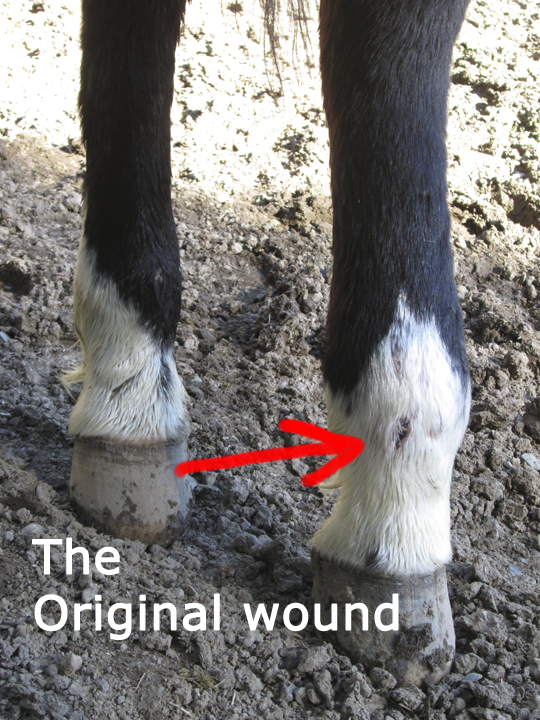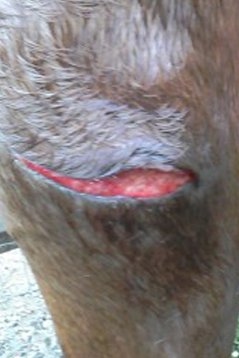Cellulitis in Horses
Spot it - Treat it - Prevent it
 Cellulitis is Painful
Cellulitis is PainfulCellulitis is a bacterial infection of the skin and underlying tissues. Once cellulitis gets started it spreads rapidly and can become very serious rather quickly. The cure? Antibiotics ASAP!
Symptoms of Cellulitis
- Tight swollen limb
- Swelling spreads up the leg
- Swelling can spread into the groin and abdomen
- Fever
- Horse does not want to use the limb
- Affected limb is painful
How Cellulitis Gets Started in Horses
It starts with a break in the skin that allows bacteria to enter.
A classic example:
Your horse gets a cut low on the leg just above the fetlock. It's not much of a cut. Nonetheless you flush the area with the garden hose, wash it down with Betadine soap and dab a little salve on it.
You notice the horse is not limping and there is no swelling. Days pass. The cut has completely scabbed over and you promptly forget about it. A week later you step out into the corral to find your horse's entire leg swollen like a sausage. What happened?
Warning signs:
- Swelling spreads up the leg
- Persistent fever
Unbeknownst to you, a small amount of bacteria entered the cut. Over the course of several days the bacteria begin to spread into the tissues of the skin until it became a full fledged case of equine Cellulitis.
Once Cellulitis takes hold, it spreads quickly. It moves right up the affected limb and can spread to the abdomen. The further Cellulitis spreads the more difficult it is to get under control. So...

Treatment for Cellulitis in Horses
Call your Veterinarian immediately as soon as you discover the swelling. Your vet will place your horse on antibiotics to kill the bacterial infection. Without a bacterial sample, your vet will not know what type of bacteria he is dealing with.
For that reason he will likely use a broad spectrum antibiotic. If the swelling does not show signs of responding, he will want to take a tissue sample to identify the bacteria and then use the most effective antibiotic accordingly.
Cellulitis is very painful so he will most likely give a pain reliever as well. Bute (Phenylbutazone) is commonly used as it relieves pain, swelling and reduces fever, too.
Normal Temperature for Horses
- Adults 98º-100º
- Foals 101º
Because Bute is a fever reducer, your vet will not want to keep your horse on it very long. Why? Because bacterial infections cause a fever. If the fever is persistent, he will know the antibiotics are not working on that particular strain of bacteria and will want to use a different kind.
Your vet will likely ask you to take your horse's temperature daily over the course of 7-10 days. This is one way to monitor the effectiveness of the antibiotics. He does not want the results masked by the use of a fever reducer like Bute.
It is a good idea to lather the affected leg up with Betadine soap, let it soak for 10 minutes or so and then rinse it off. Repeat twice a day for 2 or 3 days. This will help keep the area cleaner, especially around the original wound site.
You will want to watch the horse closely for signs of reduced swelling. It may take longer than you expect. The swelling may not go down in a uniform manner. Expect to see the swelling in the uppermost tissues go down first and work it's way down toward the ground. It is common to see the swelling pool around the lower limb before finally going away all together.
What NOT to Do With Equine Cellulitis
Do not walk your horse. Walking will not reduce Cellulitis swelling at all. It is painful and will only aggravate the problem. Hosing the leg with cool water will offer some pain relief, but it will not reduce the swelling either. The only way to get rid of the swelling is to get rid of the infection via antibiotics.
How to Avoid a Cellulitis Infection in Horses
If your horse gets cut or is recuperating from a surgery or any injury that breaks the skin, take precaution. Practice good wound care. Clean the area, apply medication and bandage the wound whenever possible to keep it clean.
A small cut in a muddy pasture can get ugly quickly. Keep an eye on it just to be sure. Cellulitis is sneaky in that it often occurs after the original wound has healed over.
 This horse does not want to stand on the infected leg
This horse does not want to stand on the infected legMore Equine Health Articles:
This information is written for the horseman to better understand and cope with the variety of disease and injury that can occur during the course of horse ownership. Always consult with your Veterinarian regarding the care and treatment of your equine.
Home > Horse Diseases > Cellulitis in Horses


